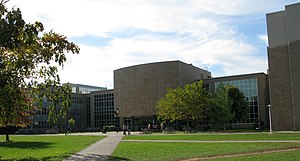McMaster Faculty of Engineering
 | |
| Established | 1958 |
|---|---|
| Dean | Dr. David S. Wilkinson |
| Location | , , |
| Website | Faculty of Engineering |
The McMaster Faculty of Engineering was established in 1958 and was modeled after some of the leading institutions in the world. The high quality of its innovative and comprehensive programs and the faculty’s strengths in education and research, has made it one of the foremost engineering schools in North America.[1]
History
In 1956, McMaster named its first Director of Engineering Studies – Dr. John W. Hodgins, a Chemical Engineering professor from the Royal Military College to develop a full engineering program for the university. The program was approved by the McMaster University Senate on February 1958. The engineering building, now (John Hodgins Engineering Building) officially opened a few months later. The first class of 25 students graduated in 1961.

Five departments established in the first two years – Chemical, Civil, Electrical, Mechanical and Metallurgical Engineering and later, Engineering Physics. The first engineering degrees from McMaster were (Master of Engineering) M.Eng. degrees, with the first ones awarded in 1959 and first doctoral degrees Ph.D. were awarded in 1965. The undergraduate programs grew in step, and by 1972, over 100 engineers received their (Bachelor of Engineering) B.Eng. degrees, with the annual total passing 200 by 1980.
The Faculty of Engineering began joint faculty appointments, research associates and collaborative research activities with McMaster's Faculty of Health Sciences courses in Bio-Engineering were offered as electives in all engineering programs. 1971 marked the start of the Engineering and Management program and later that decade, the Engineering and Society program began. In the early 1980s, the Electrical Engineering started its unique Computer Engineering program, and Mechanical Engineering began its program in Manufacturing Engineering.
McMaster Fireball
The fireball is the official symbol of McMaster Engineering. It historically comes from the coat of arms of Hamilton College. McMaster's Faculty of Engineering emerged from Hamilton College in 1958 and hence adopted a red fireball as its own emblem in 1960.[2]
It is used widely by both the faculty and students to represent everything from culture, to excellence in research and innovation. On yet another symbolic level, the fireball is used to represent the fact that energy that cuts across all areas of science and engineering. The Faculty of Engineering, which was founded in 1958 adopted the fireball as their symbol.
Student Life
The Faculty of Engineering at McMaster has a very active student life. The McMaster Engineering Society (MES) is the student-run organization dedicated to fostering "the development of well rounded undergraduate engineering students through accessible support of academics, athletics, and recreational and professional activities, while maintaining the integrity and unique traditions of our faculty society."
Facilities
Over the years, the Faculty of Engineering has expanded its facilities to meet the growing needs of both the undergraduate and graduate students. The faculty's facilities now include:
- John Hodgins Engineering Building
- McMaster Information Technology Building – recently opened 82,000-square-foot (7,600 m2) building, home to the Department of Computing and Software
- Communications Research Laboratory – stand-alone building, home to Department of Electrical and Computer Engineering
- Applied Dynamics Laboratory – research lab for Department of Civil Engineering
- Thode Library of Science and Engineering
- Nuclear Research Building, McMaster Nuclear Reactor
- McMaster Manufacturing Research Institute – 10,000-square-foot (930 m2) addition to the Engineering Building
The world's most advanced microscope
The Canadian Centre for Electron Microscopy at McMaster is home to the world's most advanced microscope. The titan 80-300 cubed microscope has a magnification of 14 million and is used for material, medical and nano-research.[3][4]
Current Departments
- Biomedical Engineering
- Chemical Engineering
- Civil Engineering
- Computer and Software
- Electrical and Computer Engineering
- Engineering Physics (Nuclear Engineering Option)
- Materials Science and Engineering
- Mechanical Engineering
